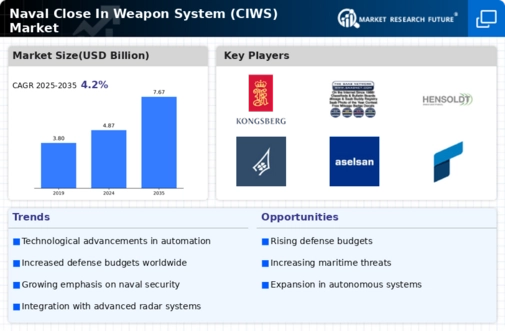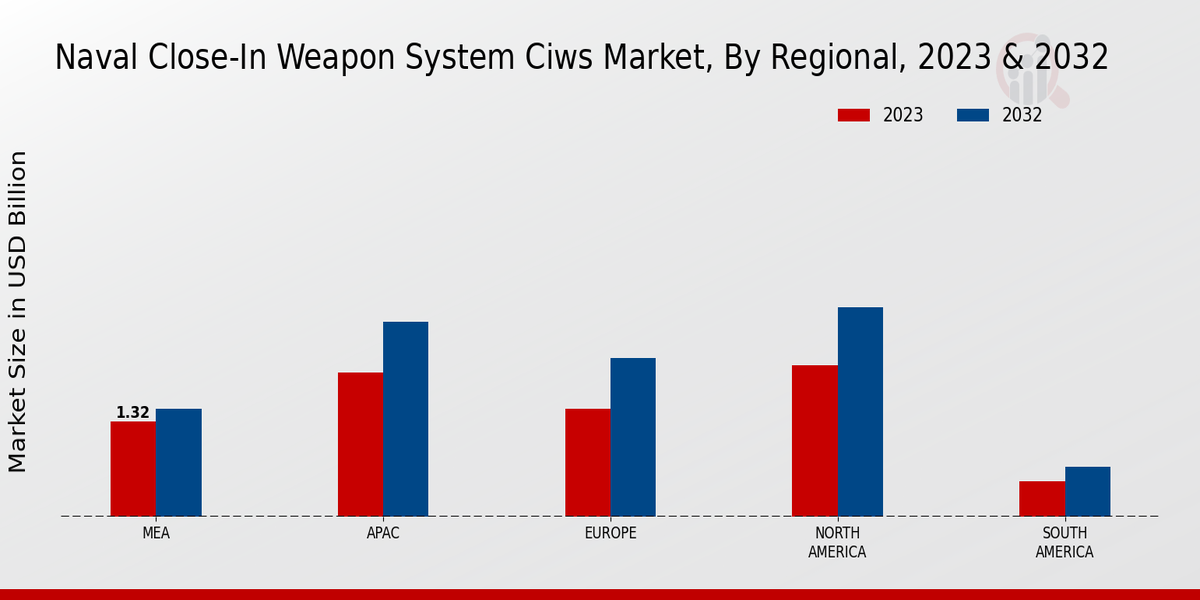Rising Maritime Threats
The Naval Close In Weapon System (CIWS) Market is significantly influenced by the rising maritime threats that nations face today. The proliferation of advanced weaponry and asymmetric warfare tactics has heightened the need for effective close-in defense systems. As naval forces encounter threats from various sources, including drones and small boats, the demand for CIWS solutions is expected to grow. Reports indicate that the frequency of maritime confrontations has increased, prompting navies to invest in systems that can provide immediate response capabilities. This trend underscores the necessity for CIWS technologies that can adapt to diverse threat environments, thereby enhancing the operational readiness of naval fleets.
Increased Defense Budgets
The Naval Close In Weapon System (CIWS) Market is experiencing a notable surge in defense budgets across various nations. Governments are prioritizing military spending to enhance national security and counter emerging threats. For instance, countries are allocating substantial resources to modernize their naval fleets, which includes the integration of advanced CIWS technologies. This trend is particularly evident in regions with heightened maritime tensions, where nations are investing in robust defense systems to protect their assets. The increase in defense budgets is projected to drive the demand for CIWS solutions, as military forces seek to bolster their close-in defense capabilities against evolving threats, including anti-ship missiles and unmanned aerial vehicles.
Technological Innovations
Technological innovations play a crucial role in shaping the Naval Close In Weapon System (CIWS) Market. The continuous development of advanced radar systems, automation, and artificial intelligence is transforming the capabilities of CIWS solutions. These innovations enable naval forces to detect, track, and engage threats with greater precision and speed. For example, the integration of machine learning algorithms into CIWS systems allows for improved target recognition and engagement strategies. As navies seek to maintain a competitive edge, the adoption of cutting-edge technologies is likely to drive the growth of the CIWS market. The emphasis on technological advancements reflects the industry's commitment to enhancing the effectiveness of close-in defense mechanisms.
Focus on Naval Modernization
The focus on naval modernization is a key driver of the Naval Close In Weapon System (CIWS) Market. Many countries are undertaking extensive modernization programs to upgrade their naval fleets, which includes the incorporation of advanced CIWS systems. This modernization is often driven by the need to replace aging platforms and enhance operational capabilities in response to evolving threats. Reports suggest that several navies are prioritizing the integration of state-of-the-art CIWS technologies to ensure effective defense against close-range attacks. As nations strive to maintain maritime superiority, the emphasis on modernization is likely to sustain the growth of the CIWS market, reflecting a commitment to enhancing naval defense strategies.
International Collaborations and Partnerships
The Naval Close In Weapon System (CIWS) Market is witnessing a trend towards international collaborations and partnerships among defense contractors and governments. These alliances facilitate the sharing of knowledge, resources, and technologies, ultimately leading to the development of more sophisticated CIWS solutions. Joint ventures and cooperative programs enable nations to pool their expertise and address common security challenges. For instance, collaborative efforts in research and development can accelerate the deployment of next-generation CIWS systems. This trend not only enhances the capabilities of individual nations but also fosters a more integrated approach to maritime security, thereby driving the demand for advanced CIWS technologies.


















Leave a Comment